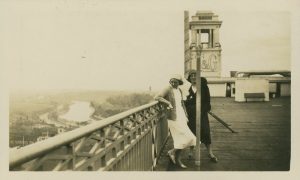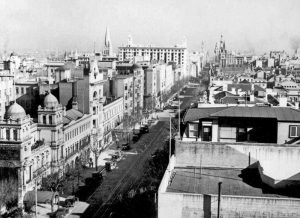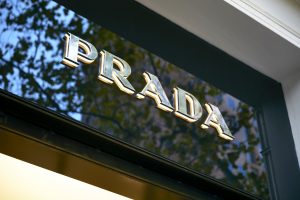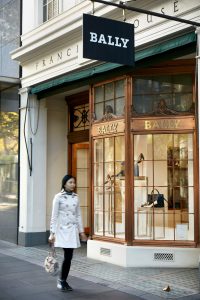How has Collins Street become the most well known luxury street in Melbourne?
20 April 2017
Circa 1928, the T&G Building was built on the corner of Russell and Collins in the ‘Paris End’ of Collins Street, establishing itself as the most prominent interwar office address in Melbourne – a place where Victorian business and commerce flourished; stamping its mark on the corporate landscape of the day.

IMAGE CREDIT: Commercial Photographic Co., Photographers: Courtesy of State Library Victoria, www.slv.vic.gov.au
It goes without saying that Collins Street features a wealth of prestigious boutiques, high-end retailers and outdoor dining culture, not to mention many fine heritage buildings and, since the 19th century, the eastern end of Collins Street has made a name for itself as the ‘Paris End’ of Melbourne’s CBD.
The term arose after the Oriental Hotel(1), located at 17 Collins Street, opened Melbourne’s first sidewalk cafe in the 1850s. Having travelled extensively around the world, hotelier Pearson Tewksbury was impressed by the sidewalk cafes he’d experienced in France and was keen to extend this cafe culture across the globe.
Melbourne’s pleasant summers presented the ideal climate for this chic café culture, an idea that was entirely unknown in Melbourne, and indeed Australia, at the time.
The hotel itself was erected in 1878 and became a favourite of Victoria’s landed nobility. During the boom of the 1880s, the Oriental was seen as one of Melbourne’s finest establishments, particularly well known for the quality of its food and drink.
In addition to the cultural influence of Europe, the ‘Paris End’ of Collins Street is lined with heritage buildings – such as the Melbourne Club, A.C Goode House and The Melbourne Athenaeum Library – built on the riches of the Victorian gold rush. The discovery of gold in the 1850s led to an influx of people to Melbourne.
The accelerated population growth and the enormous wealth of the goldfields fuelled a boom, which lasted for forty years. This period ushered in the era known as “Marvelous Melbourne”, with Collins Street at the heart of the action.
The 1880s and 90s saw Collins Street in full splendor; with remarkable buildings, beautiful shops, the latest fashion, artists, musicians, and plenty of money.

IMAGE CREDIT: Commercial Photographic Co., Photographers: Courtesy of State Library Victoria, www.slv.vic.gov.au
The prestigious Melbourne Club was a dominant cultural space after its establishment in 1838. The club was a symbol of Australia’s British heritage and continues to be one of Melbourne’s most prestigious private social clubs, located at the top end of Collins Street in a renaissance revival style building.
The Melbourne Club is architecturally known for its intact fittings and fixtures from early decorative schemes, particularly bathrooms dating back as far as 1858 and 1883.
It goes without saying that one of the biggest draw cards to Collins Street for Melbournians and tourists alike has been its luxury international retailers, including fashion heavy-weights Gucci and Max Mara, both of which can be found on the ground floor of the T&G Building.
Established in 1880, Georges Department Store enjoyed great success as one of Melbourne’s elite shopping locations. The store’s motto; Quod facimus, Valde facimus (what we do, we do well) exemplified a philosophy of exclusive goods and meticulous service. Georges was a pioneer in Australian retailing as one of the first stores to introduce passenger lifts, a cash discount system, and a bargain basement modeled ‘on the American principle’.
While the Georges Department Store may have ceased trading in 1995, the legacy of the store has undoubtedly lived on. Both lauded and loathed as a symbol of snobbery and the Melbourne establishment, Georges’ shop window displays and distinctive brown shopping bags became icons of refined shopping and epitomised the exclusive image of the ‘Paris End’ of Collins Street.
The Block, an arcade located between Elizabeth and Swanston Streets, was the place to be seen, and when the original Georges was destroyed by a disastrous fire in 1889, the elegant Block Arcade rose in its place.
Today, the finest international fashion can be found on Collins Street. From Chanel to Prada, Bally to Armani, the luxury market is well and truly covered, rivaling many international cities – with the T&G Building sitting proudly in the heart of the action.
Collins Street also hosts the family-run Harrolds Department store, founded in 1985. A world renowned fashion destination for both men’s and women’s fashion, Harrolds champions both Australian designers and the finest design houses in the world including Tom Ford, Stella McCartney, Balenciaga and Alexander Wang, to name a few.


Collins Street has also hosted its share of international celebrities. Chaotic scenes ensued outside the Melbourne Town Hall in 1964 when The Beatles appeared on the balcony just above street level. An estimated 20,000 screaming fans blocked the streets.
From French-inspired cafes, Victorian era architecture, and high-end departments stores, to hatted restaurants, heritage buildings and luxury retail shops, Collins Street has been recognised as the most well-known and highly fashionable street in Melbourne for over 200 years.
Blogger Sally Mackinnon of Styled by Sally has worked in the fashion industry since 2007. She is one of Melbourne’s most experienced personal stylists helping both male and female clients to dress with style and confidence.
@styledbysally
HERO IMAGE CREDIT: Commercial Photographic Co., Photographers: Courtesy of State Library Victoria, www.slv.vic.gov.au